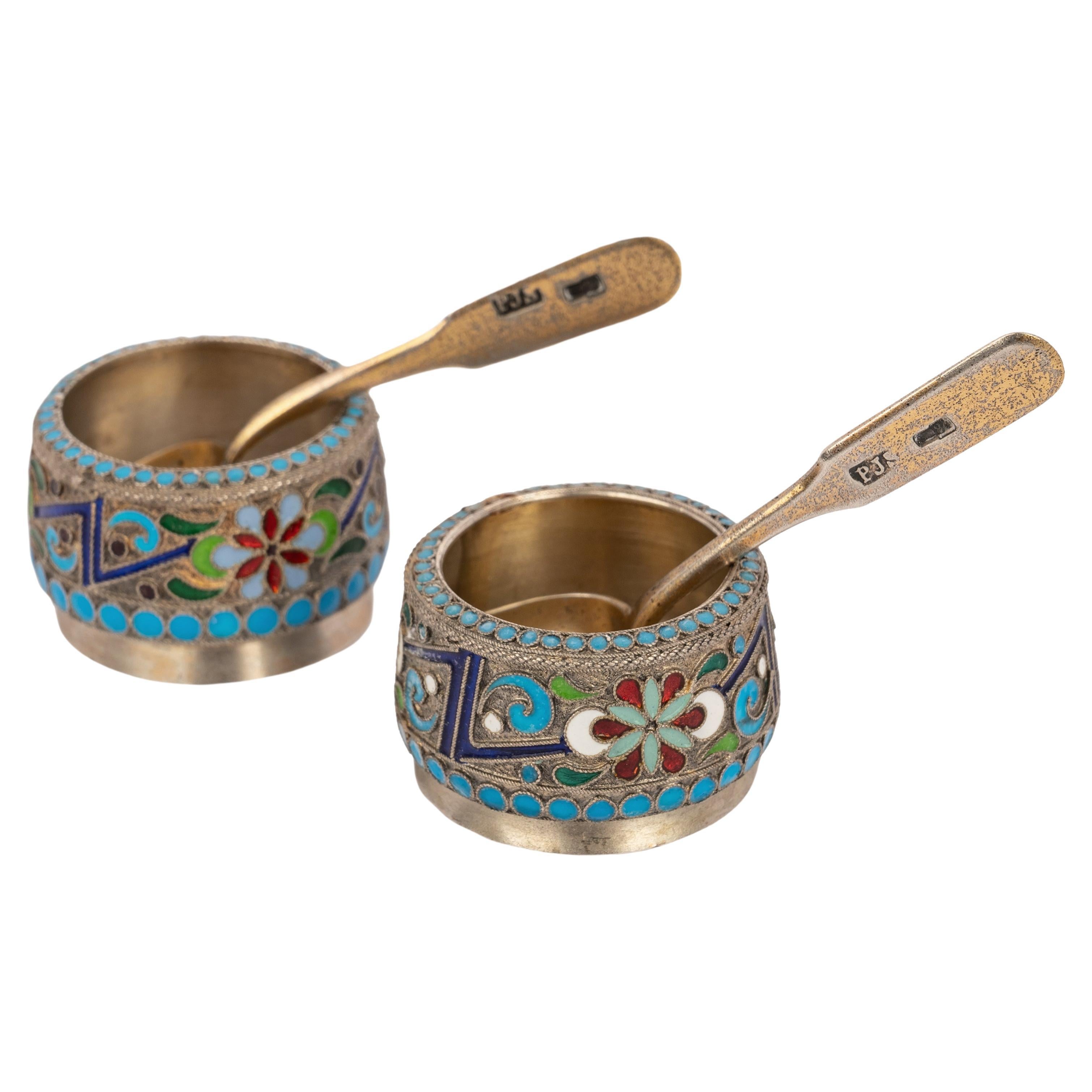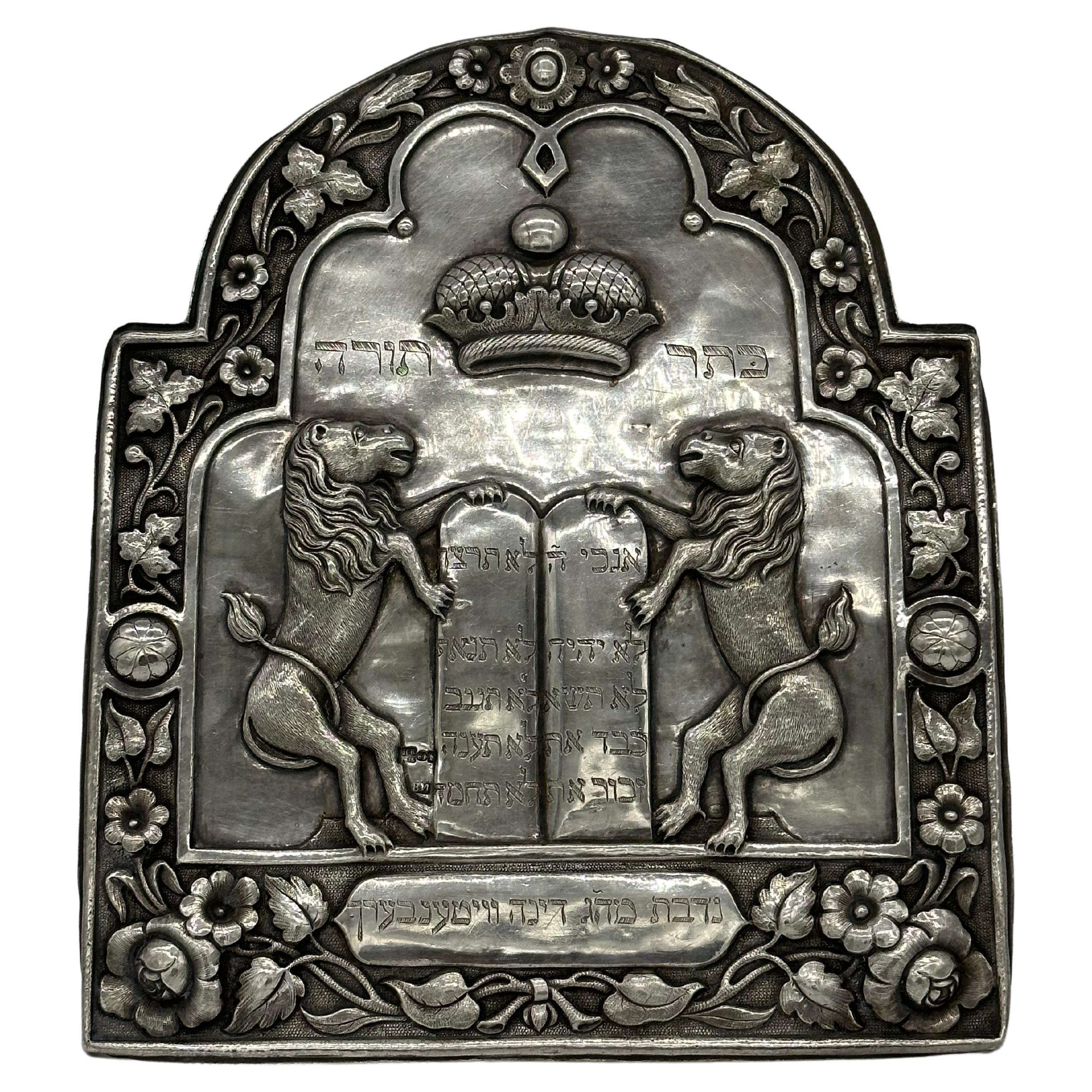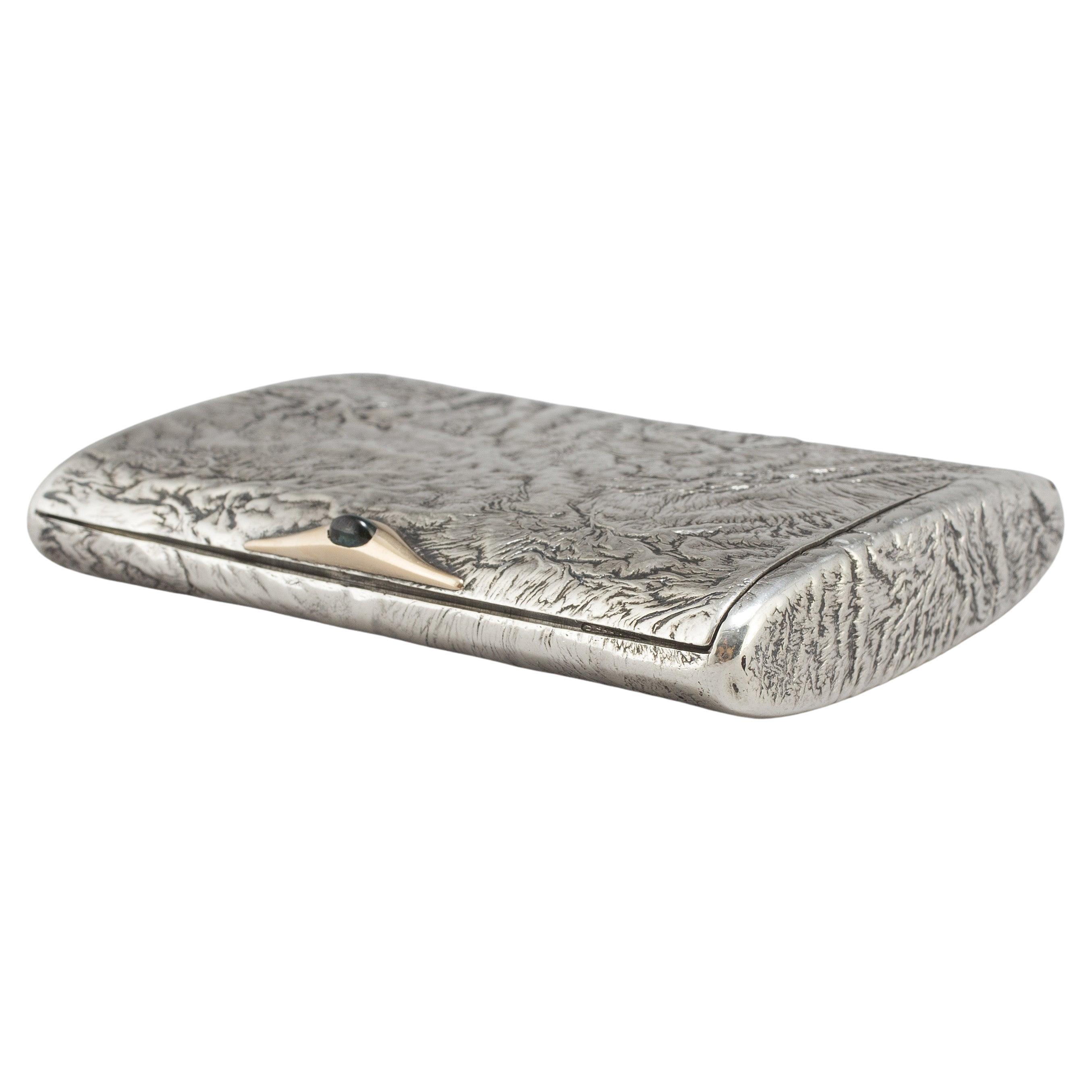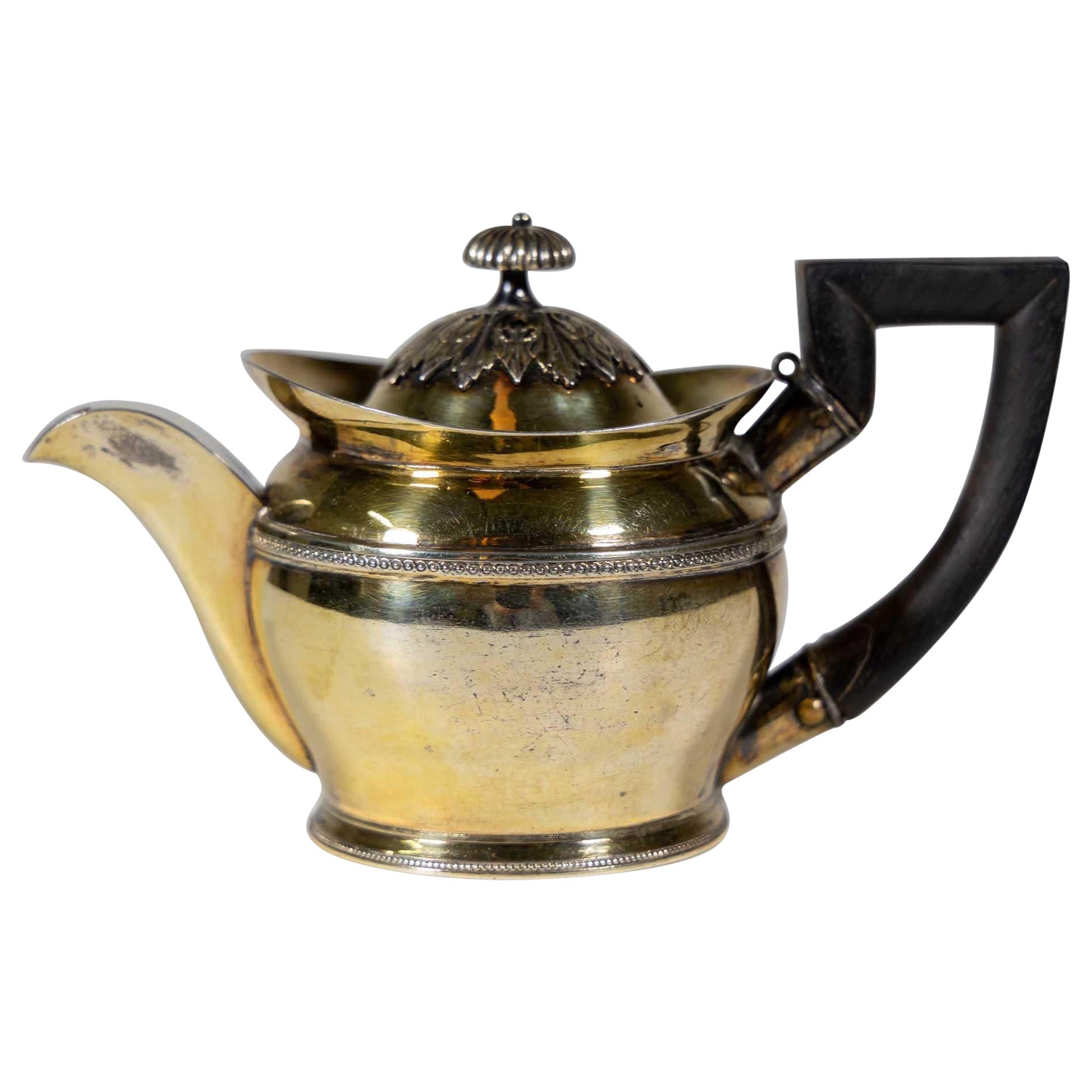Items Similar to Antique rare amusing Russian silver model of a bear, St Petersburg, circa 1890
Video Loading
Want more images or videos?
Request additional images or videos from the seller
1 of 8
Antique rare amusing Russian silver model of a bear, St Petersburg, circa 1890
About the Item
Antique 19th Century rare Imperial Russian solid silver statue depicting a bear sitting and Hogging a tree stump, heavy cast and engraved to the last detail. Hallmarked Russian Silver 84 (875 standard), St Petersburg, Maker Alexander Lokin.
This rare find is an amazing example of Russian imperial silver works, mostly made for Royalty in Russia or exporting to other wealthy families and individuals in all of Europe.
The base of this silver bear is hand carved from a massive single piece of green onyx, shaped as A Boulder. Great desk ornament or an amazing addition to any important antique silver Collection
Measurements :
Height : 5.9 inch / 15 cm
Width : 4.8 inch / 12 cm
Condition :
Perfect condition to its age, no brakes, no restorations,
Some minor scratches and age related wear.
Russian lapidary work (of the onyx base) :
The hand carved green onyx base of this sculpture is designed as A naturalistic but also Modernistic boulder, with its smooth lines its a perfect example of The late 19th century Lapidary works made in Russia. during the second half of the 19th Century, demand grew For copies of the many treasures admired by visitors on the Northern Grand Tour, which Included Russia. So shops and Galleries sprung up on the Nevsky Prospect, St Petersburg, to serve these new and wealthy visiting customers. At The same time an Influx of Italian craftsmen brought with them new skills and techniques Which they used To maximise the beauty of these hardstone objects.The Bolshevik Revolution inevitably Saw the collapse of this luxury goods trade.
Green Onyx gemstone is way lot more than its pretty look. a powerful stone that Possesses strong properties. Yet it is less famous than other varieties of Onyx. Having all The primary qualities of all forms of Onyx, it resonates around the heart chakra. The Green Onyx is highly admired for its discipline, determination and strength).
Russian silver fineness hallmarking:
The standard of fineness in Russia is usually measured in zolotniks and there are 96 Zolotniks to the russian pound. the most common fineness to be encountered is 84 and This corresponds to 875 parts per 1000 silver, which falls between the most common European standard of 800 and the sterling standard of Britain which is 925/1000.
The Russian bear :
The Russian Bear (Russian: Русский медведь, romanized: Russky medved) is a Widespread symbol (generally of a Eurasian brown bear) for Russia, used in articles and Dramatic plays since as early as the 16th century, and relating alike to the Russian Empire, The Russian Provisional Government and Russian Republic, There have been a few Examples of Russians depicting bears in coats of arms, mainly showing polar bears and Brown bears. The Novgorod Oblast coat of arms and flag include two brown bears.
The Republic of Marii El's coat of arms is a red bear with a sword and shield.
The idea of the Russian bear that pushes Russianness first appeared not in Russia but in The West. It is unknown when the Russian bear was first used in the West but One of the Earliest usages of it was from William Shakespeare's Macbeth in Act 3, Scene 4. Where Shakespeare referred to a "rugged Russian bear."
You can also find Multiple maps from the 17th to the 20th centuries show Russia as Inhabited and represented by bears. The maps started with small bears to represent Russia. The small use of the Russian bear led one scholar to suggest that the West Viewed Russia as "realms for wild animals" by pointing out the comparison between the Bears in Russia and the lions in North Africa. Over time these bears started to represent The entire country and In the end, the bears became connected with the idea of Russia, Rather than small animals on the map.
- Materials and Techniques:
- Place of Origin:
- Period:
- Date of Manufacture:1890
- Condition:Wear consistent with age and use. perfect condition for its age, no brakes, no restorations, some minor scratches and age related wear.
- Seller Location:Tel Aviv - Jaffa, IL
- Reference Number:1stDibs: LU8130235327252
About the Seller
No Reviews Yet
Vetted Seller
These experienced sellers undergo a comprehensive evaluation by our team of in-house experts.
1stDibs seller since 2023
- ShippingRetrieving quote...Ships From: Tel Aviv - Jaffa, Israel
- Return PolicyThis item cannot be returned.
More From This SellerView All
- Russian silver torah shield, judaica, Michael Karpinsky, Saint Petersburg, 1835Located in Tel Aviv - Jaffa, ILRare and exceptional example of early russian Judaica, this torah shield or tas is made From 84 silver, has the marks of the city of saint Petersburg, together with the makers Mark o...Category
Antique 1830s Russian Neoclassical Revival Sterling Silver
MaterialsSilver
- Rare Antique Novelty German silver antler and silver cigar cutter, 1890-1900Located in Tel Aviv - Jaffa, ILVery attractive German silver mounted on an antler, cigar cutter This cigar cutter is designed as oak leaves falling on the antler and in the middle There is a game bird of some kind hung from it, very realistic and well made. This kind of objects were made in Germany and Austria so they can be given as High end gifts, used as a display piece with function in men clubs...Category
Antique 1890s Sterling Silver
MaterialsSilver, Steel
- A Rare imperial Russian silver and onyx figural tray, 1st Kiev Artel, 1908-1917Located in Tel Aviv - Jaffa, ILAmazingly rare ashtray or a small trinket bowl, made in the early 20th century by the Important and high quality First Kiev Artel, The First Kiev Artel was founded in 1900 and Produced a wide variety of silver vessels as well as decorations. The quality of its work is Indicated in part by the fact that Fabergé’s Kiev branch hired away several artel members Between 1905 and 1910 and was absorbed by the Kiev branch of Fabergé . The workshop, which counted forty workers by 1909, was considered one of the best for Production of jewelry items from this important workshop are amazingly scarce and Hard To find, and only a handful of the works ever made it to public auctions. This bowl is constructed from a carved green onyx...Category
Antique Early 1900s Sterling Silver
MaterialsOnyx, Silver
- A RARE SILVER SHMIROT KIDDUSH CUP. Galician, c. 1850.Located in Tel Aviv - Jaffa, ILA RARE SILVER SHMIROT KIDDUSH CUP. Galician, c. 1850. Among some Hassidic courts, it was a practice for the Rabbi to give a blessed silver coin to his Hassidim as an amulet. Such protection might be given for all manner of life events, from healing from an illness to success in travel and the amulet was carried on the body of the recipient. This custom was particularly popular among the Ryzhiner Hassidim and these coins were called "Shmirot". To such coins were attributed extraordinary power and value and they were treasured with great care and love. this cup is marked with polish loth 12 mark which indicate silver content of 75%. Size : Height 2.3 inch / 6 cm Width : 2 inch / 5 cm After the specific event for which they had originally be given, such a coin or coins were used in the making of other objects, which maintained the special aura of the Rabbi. Such a coin would be melted in other silver with the amuletic valued being spread evenly to all the silver. Then a ritual object would be fashioned by a silversmith and the special nature of the item would be inscribed on it, indicating in one of several ways that this object had been made from "Shmirot". this objects include Kiddish cups, a Havdalah tray, a Shabbat salt holder, a Chanukkah Menorah, a Torah crown etc. This object is a Kiddish cup fashioned from such silver. On this cup, the inscription indicating Shmirot is found in the abbreviation of the words "made from shmirot k (kodesh)' " (This is the cup of Shmirot). Such cups were used for blessing the wine so that each use renewed the power of protection granted by the Rabbi. This cup was used for the blessing over wine on Shabbat and holidays. Inscription: the other iconography on the cup is of a lion that represent Through the tribe of Judah, the lion symbol came to represent the blessing, majesty, and even divine protection of the Jews. The lion symbol continued to be used even after the destruction of Jerusalem, the capital of Judah's nation, and a unicorn or a re'em, also reëm (Hebrew: רְאֵם), is an animal mentioned nine times in the Hebrew Bible It has been translated as "unicorn" in the Latin Vulgate, King James Version, and in some Christian Bible translations as "oryx" (which was accepted as the referent in Modern Hebrew),[citation needed] "wild ox", "wild bull", "buffalo" or "rhinoceros". Rabbi Natan Slifkin has argued that the re'em was an aurochs, as has Isaac Asimov...Category
Antique 1850s Sterling Silver
MaterialsSilver
- Rare George iv Gilt-Silver Inkwell, Rundell and BridgeBy Rundell, Bridge & RundellLocated in Tel Aviv - Jaffa, ILVery rare and important piece of George IV silver, highly important silver-gilt Inkwell probably by John Bridge of the renowned silversmiths Rundell & Bridge, Royal Silversmiths to t...Category
Antique 1820s English Sterling Silver
MaterialsGold Plate, Silver
- Rare German Parcel-Gilt Silver Canister, Abraham Drentwett i, Augsburg 1649-1666Located in Tel Aviv - Jaffa, ILImportant German parcel-gilt silver canister, Abraham Drentwett I, Augsburg, circa 1649-1666 Abraham Drentwett I is one of Augsburg's foremost silversmiths during the Baroque period. He was Active 1641-1666 , he is best known for having executed Queen Christina's silver throne...Category
Antique 17th Century German Baroque Sterling Silver
MaterialsSilver
You May Also Like
- Antique Pair of Russian Silver Gilt Enamel Cloisonné Salts Spoons St. PetersburgLocated in Portland, ORA good pair of antique Russian Imperial silver-gilt & cloisonné enamel salts and spoons, St. Petersburg, circa 1908. The salts of circular form and are finely decorated with multi-c...Category
Antique Early 1900s Russian Baltic Decorative Bowls
MaterialsSilver, Enamel
- Antique Chinese Export Silver Tray, circa 1890By Wang Hing & Co.Located in Jesmond, Newcastle Upon TyneAn exceptional, fine and impressive antique Chinese Export silver pen tray; an addition to our ornamental silverware collection This exceptional antiq...Category
Antique 1890s Chinese Chinese Export Sterling Silver
MaterialsSilver
- V. Gordon silver cigarette case St Petersburg Samordorok 1920. SignedLocated in Paris, FRA parcel gilt samorodok silver cigarette case by Vladimir Gordon S.t Petersburg, with green stone, c.1900 Embossed signature.. A Fine quality Russian silver cigarette case. Reticul...Category
Early 20th Century European Mid-Century Modern Sterling Silver
MaterialsGold, Silver
- Antique Anglo-Indian Sterling Silver Beaker, circa 1890Located in Bath, GBA late 19th century Anglo-Indian sterling silver beaker beautifully decorated with scroll and floral motifs. Unmarked (but tests as sterling), I would suspect this example to have...Category
Antique 1890s Indian Late Victorian Sterling Silver
MaterialsSterling Silver
- Antique Glass and Spanish Silver Ashtray Circa 1890Located in Jesmond, Newcastle Upon TyneAn exceptional, fine and impressive antique Spanish 916 standard silver and glass ashtray an addition to our ornamental collection. This exceptional antique glass ashtray...Category
Antique 1890s Spanish Sterling Silver
MaterialsSterling Silver
- Russian Jug, St. Petersburg, circa 1800Located in Greding, DESmall Russian silver jug with attached wooden handle and foliage decoration. Hallmarked on the bottom.Category
Antique Early 1800s Russian Empire Tea Sets
MaterialsSilver
Recently Viewed
View AllMore Ways To Browse
Carved Heart Gemstone
Empire Shaped Desk
Antique Brake
Antique Animal Statues
Small Silver Tree Sculptures
Antique African Carved
Bear Coat Tree
Carved Polar Bear
Hardstone Animals
Antique Solid Silver Statues Statues
Victorian Horn Of Plenty
Jensen Cactus Pattern Sterling
Aesthetic Copper Sterling
Vintage Oven Stoves
Vintage Ovens Stoves
Vintage Silver Baby Cups
Lancaster Sterling
Martin Guillaume Biennais





